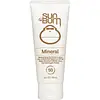What's inside
What's inside
 Key Ingredients
Key Ingredients

 Benefits
Benefits

 Concerns
Concerns

 Ingredients Side-by-side
Ingredients Side-by-side

Zinc Oxide 20%
Cosmetic ColorantWater
Skin ConditioningCocos Nucifera Oil
MaskingButyloctyl Salicylate
Skin ConditioningDiheptyl Succinate
EmollientMethyl Dihydroabietate
Butyrospermum Parkii Butter
Skin ConditioningCapryloyl Glycerin/Sebacic Acid Copolymer
Skin ConditioningSodium Stearoyl Glutamate
CleansingCetearyl Alcohol
EmollientArachidyl Alcohol
EmollientCoco-Glucoside
CleansingTocopherol
AntioxidantTheobroma Cacao Seed Butter
EmollientCetyl Alcohol
EmollientBehenyl Alcohol
EmollientBisabolol
MaskingArachidyl Glucoside
EmulsifyingMicrocrystalline Cellulose
AbsorbentCellulose Gum
Emulsion StabilisingSodium Hyaluronate
HumectantSodium Gluconate
Skin ConditioningPhenoxyethanol
PreservativeCitric Acid
BufferingEthylhexylglycerin
Skin ConditioningPolyhydroxystearic Acid
EmulsifyingZinc Oxide 20%, Water, Cocos Nucifera Oil, Butyloctyl Salicylate, Diheptyl Succinate, Methyl Dihydroabietate, Butyrospermum Parkii Butter, Capryloyl Glycerin/Sebacic Acid Copolymer, Sodium Stearoyl Glutamate, Cetearyl Alcohol, Arachidyl Alcohol, Coco-Glucoside, Tocopherol, Theobroma Cacao Seed Butter, Cetyl Alcohol, Behenyl Alcohol, Bisabolol, Arachidyl Glucoside, Microcrystalline Cellulose, Cellulose Gum, Sodium Hyaluronate, Sodium Gluconate, Phenoxyethanol, Citric Acid, Ethylhexylglycerin, Polyhydroxystearic Acid
Titanium Dioxide 11%
Cosmetic ColorantWater
Skin ConditioningIsododecane
EmollientC12-15 Alkyl Benzoate
AntimicrobialDimethicone
EmollientUndecane
EmollientTriethylhexanoin
MaskingIsohexadecane
EmollientStyrene/Acrylates Copolymer
Nylon-12
Caprylyl Methicone
Skin ConditioningButyloctyl Salicylate
Skin ConditioningPhenethyl Benzoate
EmollientSilica
AbrasiveTridecane
PerfumingDicaprylyl Carbonate
EmollientDicaprylyl Ether
EmollientTalc
AbrasiveAluminum Stearate
Cosmetic ColorantPentylene Glycol
Skin ConditioningC9-15 Fluoroalcohol Phosphate
Skin ConditioningTocopherol
AntioxidantPhenoxyethanol
PreservativeStearic Acid
CleansingDiethylhexyl Syringylidenemalonate
Skin ProtectingPEG-9 Polydimethylsiloxyethyl Dimethicone
EmulsifyingMagnesium Sulfate
PEG-8 Laurate
EmulsifyingPEG-9
HumectantPolyhydroxystearic Acid
EmulsifyingMaltodextrin
AbsorbentBenzoic Acid
MaskingIron Oxides
Propylene Glycol
HumectantPropylene Carbonate
SolventCaprylyl Glycol
EmollientDisteardimonium Hectorite
StabilisingCassia Alata Leaf Extract
AstringentAlumina
AbrasiveAluminum Hydroxide
EmollientTitanium Dioxide 11%, Water, Isododecane, C12-15 Alkyl Benzoate, Dimethicone, Undecane, Triethylhexanoin, Isohexadecane, Styrene/Acrylates Copolymer, Nylon-12, Caprylyl Methicone, Butyloctyl Salicylate, Phenethyl Benzoate, Silica, Tridecane, Dicaprylyl Carbonate, Dicaprylyl Ether, Talc, Aluminum Stearate, Pentylene Glycol, C9-15 Fluoroalcohol Phosphate, Tocopherol, Phenoxyethanol, Stearic Acid, Diethylhexyl Syringylidenemalonate, PEG-9 Polydimethylsiloxyethyl Dimethicone, Magnesium Sulfate, PEG-8 Laurate, PEG-9, Polyhydroxystearic Acid, Maltodextrin, Benzoic Acid, Iron Oxides, Propylene Glycol, Propylene Carbonate, Caprylyl Glycol, Disteardimonium Hectorite, Cassia Alata Leaf Extract, Alumina, Aluminum Hydroxide
 Reviews
Reviews

Ingredients Explained
These ingredients are found in both products.
Ingredients higher up in an ingredient list are typically present in a larger amount.
Butyloctyl Salicylate is a chemical UV filter structurally similar to octisalate. It is a photostabilizer, SPF booster, emollient and solvent. This ingredient helps evenly spread out ingredients.
According to a manufacturer, it is suitable for pairing with micro Titanium Dioxide, Zinc Oxide, and pigments.
Photostabilizers help stabilize UV-filters and prevents them from degrading quickly.
Learn more about Butyloctyl SalicylatePhenoxyethanol is a preservative that has germicide, antimicrobial, and aromatic properties. Studies show that phenoxyethanol can prevent microbial growth. By itself, it has a scent that is similar to that of a rose.
It's often used in formulations along with Caprylyl Glycol to preserve the shelf life of products.
Polyhydroxystearic Acid is a soft wax made from castor oil.
It is is a texture thickener, emulsifier, and film-former. Emulsifiers prevent ingredients from separating, such as oils and waters.
Polyhydroxystearic Acid may not be fungal acne safe.
Learn more about Polyhydroxystearic AcidTocopherol (also known as Vitamin E) is a common antioxidant used to help protect the skin from free-radicals and strengthen the skin barrier. It's also fat soluble - this means our skin is great at absorbing it.
Vitamin E also helps keep your natural skin lipids healthy. Your lipid skin barrier naturally consists of lipids, ceramides, and fatty acids. Vitamin E offers extra protection for your skin’s lipid barrier, keeping your skin healthy and nourished.
Another benefit is a bit of UV protection. Vitamin E helps reduce the damage caused by UVB rays. (It should not replace your sunscreen). Combining it with Vitamin C can decrease sunburned cells and hyperpigmentation after UV exposure.
You might have noticed Vitamin E + C often paired together. This is because it is great at stabilizing Vitamin C. Using the two together helps increase the effectiveness of both ingredients.
There are often claims that Vitamin E can reduce/prevent scarring, but these claims haven't been confirmed by scientific research.
Learn more about TocopherolWater. It's the most common cosmetic ingredient of all. You'll usually see it at the top of ingredient lists, meaning that it makes up the largest part of the product.
So why is it so popular? Water most often acts as a solvent - this means that it helps dissolve other ingredients into the formulation.
You'll also recognize water as that liquid we all need to stay alive. If you see this, drink a glass of water. Stay hydrated!
Learn more about Water